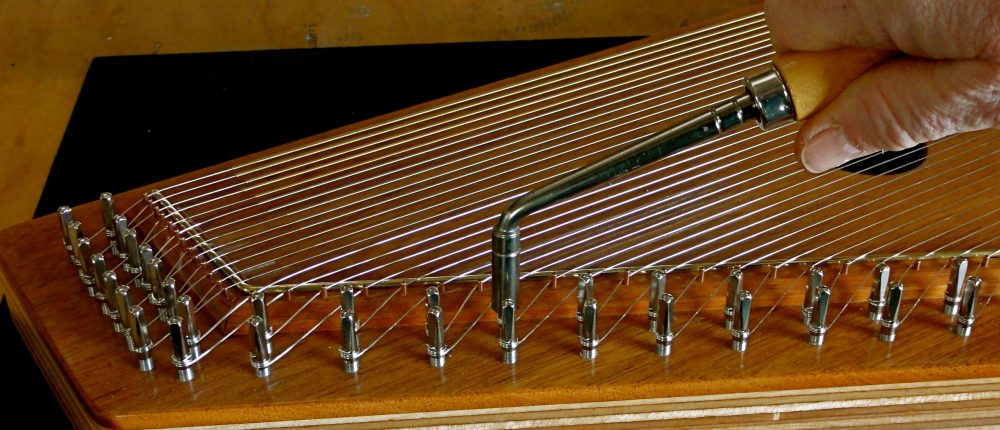 As a luthier for 40+ years I have built hundreds of dulcimers and a great variety of other stringed instruments. In 2012, my first foray into the blogosphere was titled “Whatshebuildinginthere” in which I wrote about my instrument building with an emphasis on experimentation, information, and encouragement to help other musicians and builders. At some point autoharps took control so in 2016 I began this new blog calling it “fretorfretnot”. I expected to carry on blogging about both fretted and not fretted stringed instruments but again, autoharps ruled. Only lately have I found the time to pound frets instead of tuning pins.
As a luthier for 40+ years I have built hundreds of dulcimers and a great variety of other stringed instruments. In 2012, my first foray into the blogosphere was titled “Whatshebuildinginthere” in which I wrote about my instrument building with an emphasis on experimentation, information, and encouragement to help other musicians and builders. At some point autoharps took control so in 2016 I began this new blog calling it “fretorfretnot”. I expected to carry on blogging about both fretted and not fretted stringed instruments but again, autoharps ruled. Only lately have I found the time to pound frets instead of tuning pins.
This mountain dulcimer was commissioned by a musician (Marsha) that has always played in the Ionian tuning of DAA instead of the more conventional and contemporary tuning of DAD. The DAA tuning has been traditionally used for “noter and drone” playing, that is, fretting the melody on the closer “A” string/s with a stick called a noter and allowing the middle “A” string and the lower “D” string to drone. Instead, this musician fingers chords and melody on all three string courses and uses a capo or re-tunes to play in other keys and modes. To the inexplicable astonishment of many dulcimer musicians who tune and play in DAD tuning, DAA tuning can play the same music, just using different fingering patterns.

The 1-1/2 and 8-1/2 (not shown) frets are partial frets installed under only the melody string/s
A few additions have been made to favor versatility. The 6-1/2 fret has been added to the scale for Mixolydian (or DAD) tuning. Partial frets at the 1-1/2 and 8-1/2 positions were installed under the melody course to add the extra note used in Mixolydian tunes and capoed play. Many players who tune to DAD add a full fret to the 1-1/2 position but we find it confusing and unnecessary for DAA tuning. Playing some faster melodies in DAA requires long travel up and down the fretboard and some wide finger stretches when playing chords. For that purpose a more comfortable 26-3/8″ scale length was chosen over the slightly longer scale of her other dulcimers. This small difference in scale length places the frets closer together making it easier to span chords and play faster.

The back and sides are Koa wood trimmed with grained ivoroid binding.
A western cedar soundboard, koa back and sides, wenge fretboard overlay, and mahogany fingerboard and peghead make up the body of the instrument. The four tuning machines are black chrome Gotoh planetary tuners with grained ivoroid buttons. Grained ivoroid binding trims the top and back and provides some protection from the inevitable boo-boos that attack the vulnerable edges.
 Sun, Earth, Moon, and stars create a basic theme with an asymetrical shape, cutouts in the peghead, and simple pearl and abalone inlays.
Sun, Earth, Moon, and stars create a basic theme with an asymetrical shape, cutouts in the peghead, and simple pearl and abalone inlays.
The sun on the soundboard was created by first shallowly routing the shape on the cedar top and then applying gold leaf. The gold leaf isn’t actually gold but brass that comes in unbelievably thin 5.5″x5.5″ sheets. Handling this material that is only a few molecules thick is tricky. It easily tears at the slightest attempt to move it. Fortunately I could overlap the fragments without visible seams. Application took some practice and involved applying a sizing (glue) and then burnishing on the thin brass. This and the rest of the instrument was finished with multiple coats of semi-gloss Deft lacquer.

Clip-on electronic tuners are very popular with stringed instrument musicians. They assist accurate tuning even in noisy jam sessions because they “hear” the vibrations that are conducted through the clip attachment. Many styles are available but finding a convenient and reliable place to attach them on some instruments is frustrating. For this dulcimer I removed the clip from a D’Addario tuner and replaced it with a short length of 1/8″ Delrin rod. The small star in the peghead was the perfect place to conceal an 1/8″ hole for the tuner which can be inserted and removed as needed.

You must be logged in to post a comment.